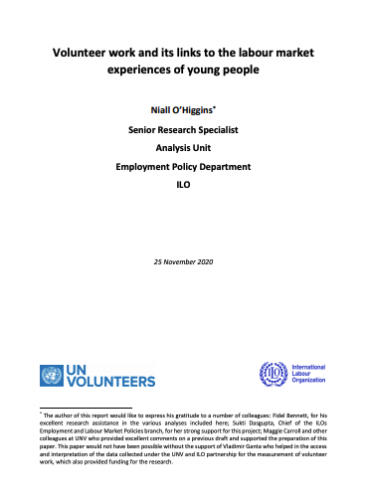Table of Contents
Introduction
In many countries, the youth labour situation is worrisome. Informality and vulnerable employment remain an unfortunate reality for the majority of employed youth around the world. Moreover, when they are not in employment, youth face difficulties accessing the labour market. This is reflected in high youth unemployment rates, high NEET (not in employment, education or training) rates, and the often difficult transition from school to work.
In the 2030 Agenda for Sustainable Development, the international community committed to increase youth employment opportunities and to substantially reduce the proportion of youth not in education, employment or training (SDG 8.6). In this context, detailed labour statistics on youth provide vital information to support governments and civil society in their efforts to design, implement and monitor policies to promote better youth employment outcomes.
Data catalogue
Below is a subset of the indicators available on youth, which is defined as persons ages 15 to 29 in the Youth Labour Market Statistics (YouthSTATS) database only. For all available indicators by age, which includes a category for persons ages 15 to 24, refer to the data page.
| Indicator | Frequency | Database | Subject | Download (with labels) | Download (with codes) | Data explorer |
|---|---|---|---|---|---|---|
| Youth working-age population with vocational education or training by sex and age (thousands) | Annual | Youth Labour Market Indicators (YouthSTATS) | Work-based learning | .csv .dta .xlsx | .csv.gz | |
| Youth work-based learners by sex and type (thousands) | Annual | Youth Labour Market Indicators (YouthSTATS) | Work-based learning | .csv .dta .xlsx | .csv.gz | |
| Youth working-age population by sex, age and education (thousands) | Annual | Youth Labour Market Indicators (YouthSTATS) | Population | .csv .dta .xlsx | .csv.gz | |
| Youth working-age population by sex, age and rural / urban areas (thousands) | Annual | Youth Labour Market Indicators (YouthSTATS) | Population | .csv .dta .xlsx | .csv.gz | |
| Youth working-age population by sex, age and school attendance status (thousands) | Annual | Youth Labour Market Indicators (YouthSTATS) | Population | .csv .dta .xlsx | .csv.gz | |
| Youth working-age population by sex, age and disability status (thousands) | Annual | Youth Labour Market Indicators (YouthSTATS) | Population | .csv .dta .xlsx | .csv.gz | |
| Youth working-age population by sex, age and labour market status (thousands) | Annual | Youth Labour Market Indicators (YouthSTATS) | Population | .csv .dta .xlsx | .csv.gz | |
| Youth working-age population by sex, age and stages of transition (thousands) | Annual | Youth Labour Market Indicators (YouthSTATS) | Population | .csv .dta .xlsx | .csv.gz | |
| Youth working-age population by sex, rural / urban areas and stages of transition (thousands) | Annual | Youth Labour Market Indicators (YouthSTATS) | Population | .csv .dta .xlsx | .csv.gz | |
| Youth working-age population by sex, education and stages of transition (thousands) | Annual | Youth Labour Market Indicators (YouthSTATS) | Population | .csv .dta .xlsx | .csv.gz | |
| Youth working-age population by sex, age and forms of transition (thousands) | Annual | Youth Labour Market Indicators (YouthSTATS) | Population | .csv .dta .xlsx | .csv.gz | |
| Youth working-age population by sex, rural / urban areas and forms of transition (thousands) | Annual | Youth Labour Market Indicators (YouthSTATS) | Population | .csv .dta .xlsx | .csv.gz | |
| Youth working-age population by sex, education and forms of transition (thousands) | Annual | Youth Labour Market Indicators (YouthSTATS) | Population | .csv .dta .xlsx | .csv.gz | |
| Youth transited by sex and status in employment (thousands) | Annual | Youth Labour Market Indicators (YouthSTATS) | School-to-work transition | .csv .dta .xlsx | .csv.gz | |
| Youth transited by sex and economic activity (thousands) | Annual | Youth Labour Market Indicators (YouthSTATS) | School-to-work transition | .csv .dta .xlsx | .csv.gz | |
| Youth transited by sex and occupation (thousands) | Annual | Youth Labour Market Indicators (YouthSTATS) | School-to-work transition | .csv .dta .xlsx | .csv.gz | |
| Youth labour force by sex, age and education (thousands) | Annual | Youth Labour Market Indicators (YouthSTATS) | Labour force | .csv .dta .xlsx | .csv.gz | |
| Youth labour force by sex, age and rural / urban areas (thousands) | Annual | Youth Labour Market Indicators (YouthSTATS) | Labour force | .csv .dta .xlsx | .csv.gz | |
| Youth labour force by sex, age and school attendance status (thousands) | Annual | Youth Labour Market Indicators (YouthSTATS) | Labour force | .csv .dta .xlsx | .csv.gz | |
| Youth labour force by sex, age and disability status (thousands) | Annual | Youth Labour Market Indicators (YouthSTATS) | Labour force | .csv .dta .xlsx | .csv.gz | |
| Youth labour force participation rate by sex, age and education (%) | Annual | Youth Labour Market Indicators (YouthSTATS) | Labour force | .csv .dta .xlsx | .csv.gz | |
| Youth labour force participation rate by sex, age and rural / urban areas (%) | Annual | Youth Labour Market Indicators (YouthSTATS) | Labour force | .csv .dta .xlsx | .csv.gz | |
| Youth labour force participation rate by sex, age and disability status (%) | Annual | Youth Labour Market Indicators (YouthSTATS) | Labour force | .csv .dta .xlsx | .csv.gz | |
| Youth labour force participation rate by sex, age and school attendance status (%) | Annual | Youth Labour Market Indicators (YouthSTATS) | Labour force | .csv .dta .xlsx | .csv.gz | |
| Youth employment by sex, age and education (thousands) | Annual | Youth Labour Market Indicators (YouthSTATS) | Employment | .csv .dta .xlsx | .csv.gz | |
| Youth employment by sex, age and rural / urban areas (thousands) | Annual | Youth Labour Market Indicators (YouthSTATS) | Employment | .csv .dta .xlsx | .csv.gz | |
| Youth employment by sex, age and disability status (thousands) | Annual | Youth Labour Market Indicators (YouthSTATS) | Employment | .csv .dta .xlsx | .csv.gz | |
| Youth employment by sex, age and school attendance status (thousands) | Annual | Youth Labour Market Indicators (YouthSTATS) | Employment | .csv .dta .xlsx | .csv.gz | |
| Youth employment by sex, age and status in employment (thousands) | Annual | Youth Labour Market Indicators (YouthSTATS) | Employment | .csv .dta .xlsx | .csv.gz | |
| Youth employment by sex, age and economic activity (thousands) | Annual | Youth Labour Market Indicators (YouthSTATS) | Employment | .csv .dta | .csv.gz | |
| Youth employment by sex, age and occupation (thousands) | Annual | Youth Labour Market Indicators (YouthSTATS) | Employment | .csv .dta .xlsx | .csv.gz | |
| Youth employment by sex, age and weekly hours actually worked (thousands) | Annual | Youth Labour Market Indicators (YouthSTATS) | Employment | .csv .dta .xlsx | .csv.gz | |
| Youth employment by sex, age and working time arrangement (thousands) | Annual | Youth Labour Market Indicators (YouthSTATS) | Employment | .csv .dta .xlsx | .csv.gz | |
| Youth employment-to-population ratio by sex, age and disability status (%) | Annual | Youth Labour Market Indicators (YouthSTATS) | Employment | .csv .dta .xlsx | .csv.gz | |
| Youth employment-to-population ratio by sex, age and education (%) | Annual | Youth Labour Market Indicators (YouthSTATS) | Employment | .csv .dta .xlsx | .csv.gz | |
| Youth employment-to-population ratio by sex, age and rural / urban areas (%) | Annual | Youth Labour Market Indicators (YouthSTATS) | Employment | .csv .dta .xlsx | .csv.gz | |
| Youth employment-to-population ratio by sex, age and school attendance status (%) | Annual | Youth Labour Market Indicators (YouthSTATS) | Employment | .csv .dta .xlsx | .csv.gz | |
| Youth time-related underemployment by sex, age and rural / urban areas (thousands) | Annual | Youth Labour Market Indicators (YouthSTATS) | Time-related underemployment | .csv .dta .xlsx | .csv.gz | |
| Youth employees by sex, age and type of job contract (thousands) | Annual | Youth Labour Market Indicators (YouthSTATS) | Employees | .csv .dta .xlsx | .csv.gz | |
| Youth unemployment by sex, age and education (thousands) | Annual | Youth Labour Market Indicators (YouthSTATS) | Unemployment | .csv .dta .xlsx | .csv.gz | |
| Youth unemployment by sex, age and rural / urban areas (thousands) | Annual | Youth Labour Market Indicators (YouthSTATS) | Unemployment | .csv .dta .xlsx | .csv.gz | |
| Youth unemployment by sex, age and school attendance status (thousands) | Annual | Youth Labour Market Indicators (YouthSTATS) | Unemployment | .csv .dta .xlsx | .csv.gz | |
| Youth unemployment by sex, age and disability status (thousands) | Annual | Youth Labour Market Indicators (YouthSTATS) | Unemployment | .csv .dta .xlsx | .csv.gz | |
| Youth unemployment rate by sex, age and disability status (%) | Annual | Youth Labour Market Indicators (YouthSTATS) | Unemployment | .csv .dta .xlsx | .csv.gz | |
| Youth unemployment by sex, age and categories of unemployed persons (thousands) | Annual | Youth Labour Market Indicators (YouthSTATS) | Unemployment | .csv .dta .xlsx | .csv.gz | |
| Youth unemployment by sex, age and duration (thousands) | Annual | Youth Labour Market Indicators (YouthSTATS) | Unemployment | .csv .dta .xlsx | .csv.gz | |
| Youth unemployment rate by sex, age and rural / urban areas (%) | Annual | Youth Labour Market Indicators (YouthSTATS) | Unemployment | .csv .dta .xlsx | .csv.gz | |
| Youth unemployment rate by sex, age and education (%) | Annual | Youth Labour Market Indicators (YouthSTATS) | Unemployment | .csv .dta .xlsx | .csv.gz | |
| Youth unemployment rate by sex, age and school attendance status (%) | Annual | Youth Labour Market Indicators (YouthSTATS) | Unemployment | .csv .dta .xlsx | .csv.gz | |
| Youth unemployment-to-population ratio by sex, age and school attendance status (%) | Annual | Youth Labour Market Indicators (YouthSTATS) | Unemployment | .csv .dta .xlsx | .csv.gz | |
| Youth unemployment-to-population ratio by sex, age and disability status (%) | Annual | Youth Labour Market Indicators (YouthSTATS) | Unemployment | .csv .dta .xlsx | .csv.gz | |
| Youth unemployment-to-population ratio by sex, age and rural / urban areas (%) | Annual | Youth Labour Market Indicators (YouthSTATS) | Unemployment | .csv .dta .xlsx | .csv.gz | |
| Youth unemployment-to-population ratio by sex, age and education (%) | Annual | Youth Labour Market Indicators (YouthSTATS) | Unemployment | .csv .dta .xlsx | .csv.gz | |
| Youth outside the labour force by sex, age and rural / urban areas (thousands) | Annual | Youth Labour Market Indicators (YouthSTATS) | Other measures of labour underutilization | .csv .dta .xlsx | .csv.gz | |
| Youth outside the labour force by sex, age and education (thousands) | Annual | Youth Labour Market Indicators (YouthSTATS) | Other measures of labour underutilization | .csv .dta .xlsx | .csv.gz | |
| Youth outside the labour force by sex, age and school attendance status (thousands) | Annual | Youth Labour Market Indicators (YouthSTATS) | Other measures of labour underutilization | .csv .dta .xlsx | .csv.gz | |
| Youth outside the labour force by sex, age and disability status (thousands) | Annual | Youth Labour Market Indicators (YouthSTATS) | Other measures of labour underutilization | .csv .dta .xlsx | .csv.gz | |
| Youth discouraged job-seekers by sex, age and rural / urban areas (thousands) | Annual | Youth Labour Market Indicators (YouthSTATS) | Other measures of labour underutilization | .csv .dta .xlsx | .csv.gz | |
| Youth inactivity rate by sex, age and rural / urban areas (%) | Annual | Youth Labour Market Indicators (YouthSTATS) | Other measures of labour underutilization | .csv .dta .xlsx | .csv.gz | |
| Youth inactivity rate by sex, age and education (%) | Annual | Youth Labour Market Indicators (YouthSTATS) | Other measures of labour underutilization | .csv .dta .xlsx | .csv.gz | |
| Youth inactivity rate by sex, age and school attendance status (%) | Annual | Youth Labour Market Indicators (YouthSTATS) | Other measures of labour underutilization | .csv .dta .xlsx | .csv.gz | |
| Youth inactivity rate by sex, age and disability status (%) | Annual | Youth Labour Market Indicators (YouthSTATS) | Other measures of labour underutilization | .csv .dta .xlsx | .csv.gz |
Latest posts
Projects

The ILO project to produce comprehensive national data on youth in the labour market, including indicators on the transition from school to work, was possible thanks to the support of the Mastercard Foundation.
F.A.Q.
School-to-work transition indicators provide a detailed classification of young people’s transition path into the labour market, shedding light on employment prospects for youth and barriers to young people’s access to decent jobs. There are two main indicators: the school-to-work transition stage and the school-to-work transition form.
The school-to-work transition stage classifies youth into three groups according to their stage in the transition: transited, in transition, and transition not yet started. According to this classification, a person has not “transited” until they are settled in a job that meets very basic criteria of stability or satisfaction. The transited population is subdivided according to two types of transition: (1) youth transited in a stable job; and (2) youth transited in satisfactory self-employment or a satisfactory temporary job.
The school-to-work transition form indicator classifies those youth that are “in transition” into four forms: those that are (1) in school and currently in the labour force (employed or not employed but available and looking for a job); (2) not in school and unemployed (looking and available for a job); (3) not in school and currently employed in a temporary and unsatisfactory job; and (4) not in school but with the intention to be employed in the future. In addition, the youth population that has not yet started the transition is classified into those who (1) are still in school and outside the labour force (not employed and not available and/or looking for a job); and those who are (2) not in school, outside the labour force and with no intention of looking for a job.
Methods

Youth Labour Market Statistics (YouthSTATS database)
Concise description of concepts and definitions, uses, sources and limitations for labour force statistics focused on youth.


Can we measure the school-to-work transition of young persons with labour force surveys? A feasibility study
The purpose of the paper is to examine the feasibility of obtaining data on school-to-work transitions of young persons from conventional labour force surveys.
Publications
Note: Many publications are available only in English. If available in other languages, a new page will open displaying these options.

World Employment and Social Outlook: September 2024 Update
This brief focuses on the evolving relationship between labour and capital income, challenges facing youth in the current job market, and progress towards key SDGs as 2030 approaches.

Global Employment Trends for Youth 2022: Investing in transforming futures for young people
The 2022 edition discusses the impact of the COVID-19 pandemic on young people and their labour market prospects during the recovery and beyond.

Volunteer work and its links to the labour market experiences of young people
This paper looks at how volunteering can benefit young people at the start of their careers. It uses existing literature and undertakes further longitudinal analysis, including on the effects of volunteering on young people as they seek to access good jobs.

From school to work: An analysis of youth labour market transitions
This brief presents an analysis of youth labour market outcomes, with a particular focus on two new school-to-work transition indicators published on ILOSTAT. It first introduces the new indicators. It then analyses the distribution of youth by stages of transition across a set of 60 countries for which the ILO has derived indicators from national labour force survey microdatasets.

Labour market access – a persistent challenge for youth around the world
The fifth issue of our series Spotlight on work statistics uses the first ever global estimates of youth not in employment, education or training along with other youth labour market indicators to explore the situation of youth in labour markets around the world, and unveil the additional challenges they face.




